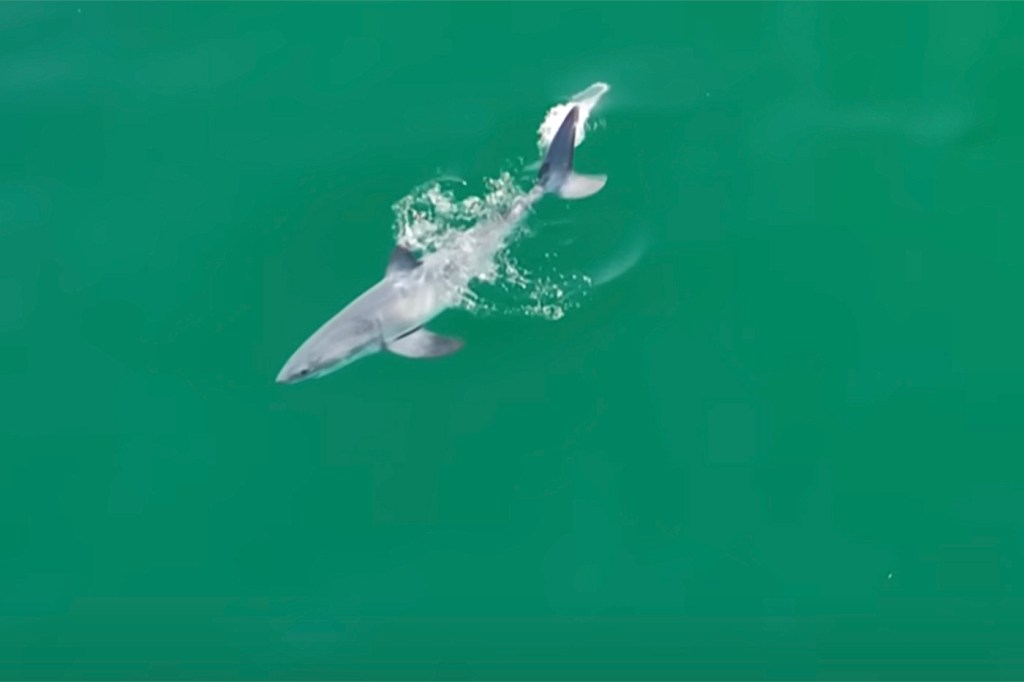Was a baby great white shark caught
on camera for the first time?
Northeastern expert explains why it
could be major discovery

What is believed to be a live newborn great white shark has been spotted on camera for the first time ever, potentially providing marine biologists with the best look yet at where the apex predator may give birth.
Dan Distel, Northeastern professor of marine and environmental sciences, says the discovery could play a role in helping scientists better understand the life cycle of the great white, but more work needs to be done to confirm the legitimacy of the discovery.
The footage was captured via drone by wildlife photographer and filmmaker Carlos Gauna last summer while he was filming in Southern California. With him was Phillip Sternes, a biology doctoral student. Research authored by Gauna and Sternes on the discovery was published this week in the scientific journal Environmental Biology of Fishes.
“As scientists, we’re always cautious about a single observation,” Distel says. “The observation has been documented in a peer review journal, but I think there are many things that have to be verified with respect to this observation. I don’t know how controversial it is, but I do know that this has not been verified or independently verified in any particular way.”
Great white sharks are the largest predatory fish on Earth. While much is known about the white pointer there are “major gaps in white shark life history such as information on breeding and newborns,” the pair write in their report.
It’s been posited that female sharks use the area of Santa Barbara, California, to the northern area of Baja California in Mexico to give birth. But up until now, that hasn’t been observed, the pair said. The shark was found swimming 1,300 feet off the coast of Carpinteria, California, reports USA Today.

While the pair could not definitively confirm whether what they captured on film was a baby great white shark, there are four major clues that suggest it might be, they said.
The first clue is the shark’s dorsal fin. It is much more rounded than that of an adult’s. The second clue was the white membrane-like substance the shark was sloughing off itself while swimming, which is believed to be its embryonic layer. The third clue is the shark’s color. It’s completely white, while adult great white sharks are gray with a white underbelly. And the fourth clue is the shark’s size. It’s roughly 5 feet long. An adult female great white shark is roughly 15 to 16 feet while an adult male is roughly 11 to 13 feet.
Featured Posts
The pair note there is also the possibility that the shark could have an unknown skin disorder that could explain white coating that it is sloughing off itself. But the shark looks very similar to dead baby sharks found in the wild, they said.
Distel says there are certainly challenges in confirming whether the shark caught on film was in fact a baby great white. The pair did not have any physical contact with the animal or collect any part of its body to test its DNA.
“If they had been able to catch the animal, they could have been able to do DNA analysis. If they had even sampled the water around the animal, it might have been possible to do what we call eDNA analysis, or environmental DNA analysis, because you saw that animal appears to have been shedding,” he says.
Situations like this often happen when an unknown species of animal is observed in the wild, he notes.
“This is why species discovery has historically been pretty slow,” he says.
While a bit skeptical of the discovery, Distel said if it is factually accurate it could be of major significance in helping us study and protect the species.
Great white sharks are not endangered but they are listed as being “vulnerable” by the International Union for Conservation of Nature as they are subject to poaching and other harmful fishing practices.
“Anything that gives clues to the lifecycle of their reproductive behaviors of any species is really important in understanding and preventing their decline or extinction,” Distel says. “The ocean is very highly interconnected. All the species in the ocean are very connected. Top predators like the great white sharks have impacts right through the food chain.”
As a top predator, great white sharks play an important role in preventing overpopulation, he notes.
While great white sharks often get a bad rap by humans, there are fewer than 10 human deaths caused by great white sharks every year globally, Distel notes. Humans, on the other hand, kill around 80 million sharks every year globally.
And that the footage was documented by a wildlife filmmaker lends credence to the impact regular citizens who don’t necessarily have doctorate degrees or research backgrounds can have in helping make scientific discoveries, Distel notes.
“I think it’s really quite valuable,” he says. “I’m really quite interested in figuring out ways that the general public can contribute more because it’s not just species discovery. It’s also uncovering different behaviors and biology of different species, and also just knowing where species are at any given time.”











